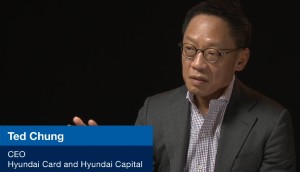
Long after CEO Ted Chung brought the credit-card company back from a crisis, he continues to embrace the idea that constant change is the best way to keep a company ready for anything. McKinsey CEO Interview
Just a few years after Hyundai Card was established, Ted Chung joined the company as CEO only to find that the business was in big trouble. With the credit-card company poised to lose millions, Chung took the unusual steps of boosting employee salaries and increasing spending, including for a new $50 million advertising campaign. It paid off. He has since honed a strongly held view on the power of design to keep his brand distinctive—one that ranges from such unusual innovations as sponsoring tourist visits to his ultramodern headquarters and the new, automated credit-card “factory” to developing the company’s own unique font. In this interview with McKinsey’s Rik Kirkland, Chung, who was recently named vice chairman of Hyundai Card and Hyundai Capital, explains how crisis helped define his leadership and why he sees continually challenging the status quo as the surest way to stay on top. An extended and edited transcript of Chung’s remarks follows.
Managing during crisis. Nobody wants a crisis. But, actually, the beauty of crisis, if you have to experience it, is that it speeds everything up and makes anything possible. When I joined, in 2003, the company was just two years old, and the crisis was coming because our whole industry had grown too fast and extended too many credit lines to low-quality customers. Nobody loved this company. We were just another commodity product.
So after securing 40 percent market share in new-member acquisitions for the first two years, the previous executives may have thought we were the champions. But shortly after I arrived, when I did the math, I thought at first I had made some mistake. But I ran the numbers again, and they were correct: we were set to lose $1.5 billion to $2 billion within 12 months.
I brought my blanket to the office and I slept there overnight ten times, thinking about my next step. My biggest move was that I decided not to make any cuts. Instead, I decided to spend more money to try to dramatically reposition the company and put it on a different, more profitable growth path. If I were losing $20 million or even $200 million, I would cut everything. But when you lose $2 billion, that’s different. The key question, I realized, was that we needed to figure out what kind of credit-card company we wanted to be. After all, Amex, Citibank, Discover, may all be credit cards, but they are not in the same industry at all. My instinct, without any experience in the business, was that we needed to be a lifestyle credit-card company, more like Amex—one with a unique identity and the strongest brand loyalty. And that required a new business model. So the next part of my plan was to increase everybody’s salary by 10 percent. Because when a company has a crisis, employees start to think, “OK, I need to update my resume.” If you want to overcome your crisis, then you need to retain your key employees. Once you lose your people, that’s it. I also changed more than half of my executive team because some of them tried to tell me, “This is how to run a credit-card business.” When people say things like “This is the way to run a business. There’s no other way,” then that’s a problem. I called a few headhunting companies and said to them, “I want every smart brain on the street. I don’t care whether they have a credit-card background or not.”
A few months later, we invested in a $50 million campaign to launch our new credit card. We had the only credit-card advertising at that point in Korea. Many people said I was crazy. But my response was, “No. I’m spending maybe $100 million more, overall. What’s the difference between $2 billion and $2.1 billion, when you die?”
…
About the authors
Ted Chung is vice chairman and CEO of Hyundai Card and Hyundai Capital. Rik Kirkland is the senior managing editor of McKinsey Publishing, based in McKinsey’s New York office.
More: http://www.mckinsey.com/Insights/Leading_in_the_21st_century